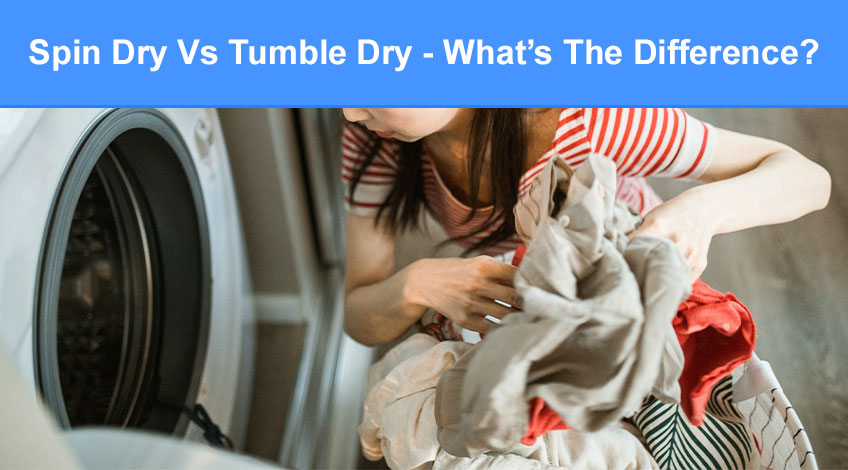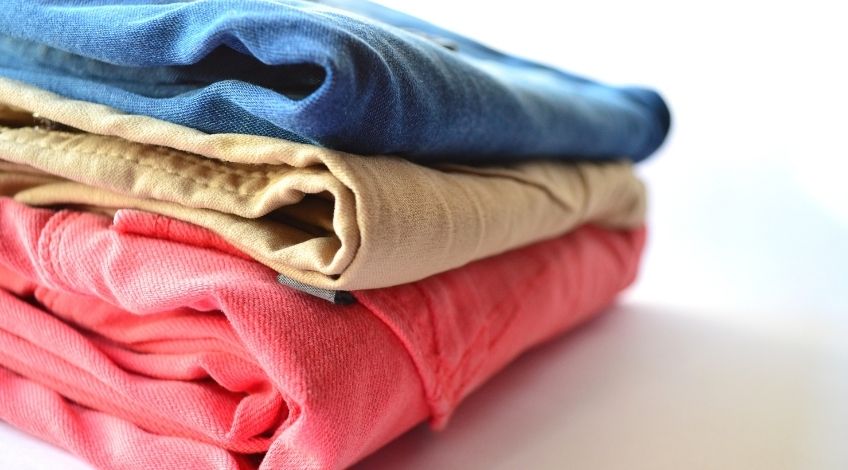
Spin Dry Vs Tumble Dry – What’s The Difference?
The short answer is that spin drying is done in the washing machine towards the end of the wash cycle to get the clothes relatively dry. Whereas tumble drying is done in a separate machine using heat to get the clothes completely dry.
If you want to find out the whole story, keep reading.
What Does Spin Dry Mean?
To spin dry wet clothes is a function performed in the washing machine after the clothes have been washed to remove excess water. The drum spins at a fast speed and uses centrifugal force to expel the water from the clothes as they spin.
Back in the 1960s and earlier, housewives had separate appliances that were called “spin dryers”. Many at that time, never had washing machines and had to wash all of their clothes by hand.
The spin dryer allowed them a break from wringing the clothes to remove moisture. The spin dryer also used centrifugal force to expel the water from the clothes.
With the advent of modern domestic washing machines, the spin dryer became obsolete. Nowadays the washing machine spins those clothes to remove enough water to make them easy to handle. However some households still prefer to use a spin dryer for drying clothes as opposed to a tumble dryer.
Water is heavy, in fact one litre of water weighs one kilogram, can you imagine just how much a full wash load would weigh if it wasn’t spun in the machine?
The amount of time it would take to dry soaking wet clothes is phenomenal which would mean the cost of running a tumble dryer if the laundry wasn’t spun first would be astronomical.
The spin cycle happens towards the end of the wash cycle and removes most of the water from the clothes using centrifugal force. This helps to quicken the drying process by removing most of the water before the clothes leave the drum of the washing machine.
How Fast Do Washing Machines Spin Clothes?
Washing machines have spin cycles that are measured in revolutions per minute (RPM). Which means if your machine has a 1200 RPM spin speed the drum rotates 1200 times every minute.
The Speed of the spin cycle on your machine is dictated by the fabrics being washed. For instance;
- Silks: 400 RPM
- Delicates: 600 RPM
- Denim: 900 RPM
- Woollens: 1200 RPM
- Cottons: 1400 RPM

Can You Only Use The Spin Cycle After Using a Wash Cycle?
The spin cycle is typically used at the end of a wash cycle on your washing machine. However, that’s not the only time it can be used. You can give garments an extra spin if there is still too much water remaining after the cycle has finished.
You can also put rain soaked clothes in the machine and run a spin cycle to remove much of that rain water.
What Does Tumble Dry Mean?
The term tumble dry usually refers to putting washed and spun clothes in a tumble dryer to use heat to remove excess moisture and make the clothes completely dry. Clothes should leave the tumble dryer completely dry as opposed to damp at the very best from the spin cycle or a spin dryer.
Tumble dryers expose your clothes to high temperatures to remove moisture and a spinning action that agitates the clothes to allow heat to circulate all round the clothes.
The high heat and constant movement enables the clothes to dry in a relatively short time span.
Tumble drying clothes is a great way to get wet clothes dry when the weather is too bad to dry outside. However, using a tumble dryer does use quite a large amount of electricity which means it’s going to cost quite a bit.
When Should You Use A Tumble Dryer?
You should use a tumble dryer sparingly as it not only uses quite a lot of electricity, it also increases the wear of many fabrics. You should limit the use of your tumble dryer to times when;
- It’s too wet or too cold to line dry clothes
- You need clothes dry fast
- Clothes require a particular temperature to dry them
- To ensure the clothes are dry enough to store away
- There is a huge pile of laundry that needs to be dried
When Should You Not Use A Tumble Dryer To Dry Your Clothes?

As we just said, drying your clothes in a tumble dryer is a great way to ensure the clothes are completely dry before storing them away. But there are some items of clothing that shouldn’t be tumble dried.
These include clothes that have care labels indicating they should not be tumble dried including;
- Silk
- Wool
- Leather Or Suede
- Faux Leather Or Faux Suede
- Spandex
- Lycra
- Elastane
- Clothes with Sequins or other glued on pieces
- Polyester
Blended polyester garments can be tumble dried but only at low temperatures.
There are many clothes that can be tumble dried which include;
- Denim
- Cotton
- Cotton Bedding
- Towels
What’s The Difference Between Spin Drying & Tumble Drying?
The difference between spin drying and tumble drying is that spin drying relies solely on centrifugal force to remove excess water from the clothes and doesn’t dry them completely.
Whereas tumble drying uses heat produced by an electric heating element which is forced around the clothes by an electric powered fan whilst the drum spins to agitate the clothes allowing that hot air to circulate around and dry them.
The spin dry cycle tends to be noisy, as it spins at very high speeds. It also uses far less electricity than tumble drying because it does not heat up at all. Spinning clothes doesn’t dry clothes completely and takes a considerable amount of time to remove excess moisture.
Tumble drying tends to be quieter but uses far more electricity to heat the air and then blow it around the laundry to help dry it. It also is typically far quieter than spinning when in operation.
Also clothes tend to be less wrinkled or creased on leaving a tumble dryer compared to a spin cycle. There are limits to the types of fabrics that can be dried using a tumble dryer, these limitations don’t apply to the spin cycle.
If you decide to use the spin cycle on delicate items, you should adjust the spin speed to as low as possible to prevent damage.

What About Spin Dryers? Are They Any Good?
As we said earlier, some households still like to use a separate appliance known as a “spin dryer”, which will literally do just the spin cycle on its own.
When compared to tumble dryers, spin dryers tend to be cheaper to purchase and are more portable. Whereas tumble dryers are more expensive and are not usually portable either.
Will Spin Drying Damage Clothes?
The majority of clothes that are put in a spin dryer will not get damaged. Some delicate items like lace and silk could become damaged in the spinner but it is safer (generally speaking) than putting items of clothing in a tumble dryer.
What Are The Price Differences Between Spin Dryers & Tumble Dryers?
The average price of a spin dryer in the UK is anywhere between £100 to £200 whereas the average cost of a tumble dryer is around £200 for a vented tumble dryer, £250 for a condenser tumble dryer and around £300 to £600 for a heat pump tumble dryer.
SEE ALSO: Synthetic Dry Vs Cotton Dry – What’s The Difference?
Frequently Asked Questions
Spin dry is not the same as tumble dry. Spin dry relies on centrifugal force to extract moisture from clothes. Whereas tumble dry uses electrically produced heat to remove excess moisture. Spin drying will never completely dry clothes but tumble drying will.
It is possible to shrink clothes using the spin cycle. The length of the spin cycle and the speed the drum spins at can all affect the shrinkage rate of some garments.
It is better for the clothes to be air dried as it is natural and less violent. However in bad weather, tumble drying is better because you will get your clothes dry even if the weather is bad.




